
Guests
- Antonia Juhaszauthor of the new Harper’s piece, “Thirty Million Gallons Under the Sea: Following the Trail of BP’s Oil in the Gulf of Mexico.” She’s also author of Black Tide: The Devastating Impact of the Gulf Oil Spill.
We turn now from the Arctic to the Gulf of Mexico, where drilling has resumed near the site of the BP-operated offshore oil rig that exploded five years ago in the worst industrial environmental disaster in U.S. history. On Wednesday, Harper’s Magazine revealed a Louisiana-based oil company purchased the area from BP and is now drilling into the Macondo reservoir. The report also looks at the ongoing impact of the 2010 spill. We speak to reporter Antonia Juhasz, who spent two weeks on a ship in the Gulf of Mexico as part of a scientific research mission exploring the impacts of the BP Gulf oil spill. She participated in a dive in the Alvin submarine nearly a mile below the ocean surface, getting closer to the site of the blowout than anyone had ever been.
Transcript
NERMEEN SHAIKH: We turn now from the Arctic to the Gulf of Mexico, where drilling has resumed near the site of the BP-operated offshore oil rig that exploded five years ago in the worst industrial environmental disaster in U.S. history. On Wednesday, Harper’s Magazine revealed a Louisiana-based oil company purchased the area from BP and is now drilling into the Macondo reservoir. The report also looks at the ongoing impact of the 2010 spill. BP insists most of the oil has now dissolved or evaporated and did not settle on the ocean floor.
AMY GOODMAN: But that’s not what our next guest found. Antonia Juhasz spent two weeks on a ship in the Gulf of Mexico as part of a scientific research mission exploring the impacts of the BP Gulf oil spill. She participated in a dive in the Alvin submarine nearly a mile below the ocean surface, getting closer to the site of the blowout than anyone had ever been.
Well, Antonia Juhasz joins us now to describe what she saw. Her report is in the new issue of Harper’s Magazine. It’s headlined “Thirty Million Gallons Under the Sea: Following the Trail of BP’s Oil in the Gulf of Mexico.” She’s also author of Black Tide: The Devastating Impact of the Gulf Oil Spill.
Welcome back to Democracy Now! What did you see? How did you do this?
ANTONIA JUHASZ: A pleasure to be here. You know, it was an amazing adventure, to say the least. The Alvin submarine is—celebrated its 50th anniversary last year. It’s an incredibly important—the first and the last human-occupied submarine still available for research, so it’s an incredible experience to be able to go down in it. And Dr. Samantha Joye, one of the leading experts on oil and gas in the Gulf of Mexico, who has led the research looking at the impacts of the BP disaster, was my guide, with our pilot, Bob Waters, who’s both, thank goodness, an engineer and a pilot, so if anything goes wrong with the sub, he’s there with us.
So we went within two miles of the site of the blowout, which is as close as you can get, because the wreckage of the Deepwater Horizon is still there. And we—it took two hours to get down. We then made a curve around the site of the disaster, taking sediment samples all along the way. And when we got down there, you know, really, the most stark thing to report was that it—there’s basically nothing there. It’s a moonscape. Basically, all of the sea life that could get out of the way of the oil got out of the way of the oil; everything that couldn’t was just, in Dr. Joye’s words, nuked and killed. And there is a blanket of oil, as much as two inches thick, covering 3,000 square feet of the ocean floor.
NERMEEN SHAIKH: Well, BP insists most of the crude oil that leaked in the Deepwater Horizon oil rig explosion dissolved or evaporated before it reached land, and did not settle on the ocean floor. In February, Politico published an article titled “No, BP Didn’t Ruin the Gulf,” that was written by BP Senior Vice President of Communications Geoff Morrell. He wrote, quote, “Natural oil seeps release up to the equivalent of nearly six Exxon Valdez spills in the Gulf each year, and microbes in the Gulf have adapted over time to feast on oil.” Morrell also noted the spill occurred in deep water and, quote, “more than 40 miles from shore in a temperate climate. That allowed a lot of oil to dissolve, evaporate, deteriorate or be physically removed before it reached land.” Antonia, could you respond to that?
ANTONIA JUHASZ: Well, my article responds to it really well, so let me do the short version, because there’s so much to unpack there. So the first thing is, yes, there’s naturally occurring seeps that exist in the Gulf of Mexico. This is a teeny tiny bit of oil across the ninth largest body of water in the world, and it seeps out over millennia, and natural environments do exist around them, and they’re actually quite beautiful. But that is such a small amount in comparison to the huge, momentous, enormous shock of 170 million gallons of oil being released at once at the bottom of the ocean floor. There’s absolutely no comparison.
But he’s right that there is such a thing as naturally occurring microbes that eat oil. There’s a number of problems, though. The first thing is, microbes did eat some of the oil, but they only ate what they could, which means that, according to Dr. Joye, they left about 30 million barrels still behind, which is the equivalent of—excuse me—three Exxon Valdezes. But what they left behind is what they didn’t want to eat, which is also the most toxic part of the oil. And that most toxic part of the oil is what remains on the bottom of the ocean floor. In addition, the Corexit, the dispersant that BP just expelled into the Gulf of Mexico, Dr. Joye found, is actually a deterrent, which kept away the microbes that would have eaten more oil. So the Corexit, in addition to being—so the Corexit is toxic, the oil is toxic, and studies have found that the combination of the two is 50 times more toxic than either alone, both of which are still at the bottom of the ocean floor, because the Corexit stays there, too. But the Corexit also inhibited the presence of more of those naturally occurring microbes. And also what Dr. Joye’s science has found is that the microbes are long done eating. So, what’s left is going to be there forever, because the bottom of the ocean is cold and dark. It’s a refrigerator. It’s a naturally preserving environment. So that most toxic part of the oil and the Corexit is now a permanent feature of the Gulf of Mexico and continuing to cause harm permanently, as well.
AMY GOODMAN: So talk about the story you are breaking in Harper’s about where BP is planning to drill.
ANTONIA JUHASZ: So, this isn’t BP—I guess that’s the one good piece of news out of it. But while we were down there, in the midst of nothing, we saw these two horizontal tracks running along the ground, clearly man-made, and we followed them for a while to try and figure out what they are. And we figured they must be seismic cables, which are actually used to determine how much oil is in the ground. And then, once I got back to shore, I spent much of the last year investigating what these cables meant.
And what I uncovered was that the Department of Interior had very quietly, without anyone knowing—no press attention, no public attention—broken up BP’s lease, so that BP now only owns basically the wreckage, the area of the wreckage. And all the rest was sold to another company, LLOG, a Louisiana-based company, very active in the Gulf of Mexico, and it was given the rights to drill for oil and gas there. And it submitted plans in October. Those plans are—you know, I have to say, it sort of nearly brought me to tears in how similar they were to BP’s original plan. And within a month, they got approval to start drilling, and they are now drilling at an adjacent site, cutting over under the ground, and they’re already underway at the adjacent site.
And this is just part of the business as usual in the Gulf of Mexico. Basically, everything is not only back to normal, but you’ve got a company drilling in this most treacherous and still unbelievably harmed part of the Earth, and you have even companies, including BP, but in particular Chevron and Shell, moving way farther out in the Gulf of Mexico, drilling twice as deep—twice as deep as the Deepwater Horizon was drilling and 150 miles further out into the ocean.
NERMEEN SHAIKH: But are the regulations in place now that make that drilling safer?
ANTONIA JUHASZ: The Obama administration has made changes, and they’re welcome changes. But they’re piecemeal. They’re tiny changes in response to a huge problem. So, you know, thank you for putting in place regulations—that’s great. But the regulations are—you know, the companies make a mistake; the regulation sort of chops a little piece off of what was identified as a problem, and a little piece here and a little piece there. But nothing addresses the systemic problems of just the incredible inherent risk and difficulty and technological, you know, profoundness of how difficult it is to do this type of drilling. But that’s just getting at the drilling.
What hasn’t been addressed is, basically, neither BP nor any other company operating in the Gulf really knows what to do when a blowout happens. They don’t really have the tools to deal with it. And in the most recent legal findings, the judge, looking at this disaster, said, yes, BP is responsible for causing the disaster, but basically, because federal regulators don’t make them know what to do after a blowout, and none of the other companies know what to do, basically nobody’s to blame. And if nobody’s to blame, then nothing is likely to change. So we’re still in the same place we were before the blowout.
AMY GOODMAN: So what do you think needs to happen?
ANTONIA JUHASZ: You know, the United Nations has told us very matter-of-factly, as has every climate scientist in the world, just about, that 80 percent of fossil fuels need to stay in the ground, if we’re to avert the worst of climate crisis. To me, that means that there are just certain areas that have to just start being checked off the list as just no-go zones, that it’s too risky, we don’t need it that badly, and the risks are too profound. And to me, offshore drilling belongs on that list. Instead, the Obama administration, in addition to okaying—almost okaying the Shell project, has opened up for the first time drilling off the Atlantic coast, from—you know, up to Virginia, where new, for the first time, oil and gas development would take place off the Atlantic coast starting in 2017.
AMY GOODMAN: Final comments, as you come from this very unusual dive that you did, in the last 30 seconds, and you come up now for air?
ANTONIA JUHASZ: You know, I think it’s—I didn’t appreciate the significance of the cycle of life that exists from the bottom of the ocean to the top of the ocean to us. So, there’s little creatures, like tube worms, that are supposed to live on the bottom of the ocean, but most of them don’t anymore, as a result of the oil spill, that break down food particles. And those food particles are critical for phytoplankton, which needs to eat it. And the phytoplankton provide 50 percent of the oxygen on the Earth. So if they don’t have food and they can’t live, then we can’t live, either. And as Dr. Joye said, you know, if you kill the Earth—I mean, if you kill the oceans, basically, none of us can live. And that was an important message to take forward for me.
AMY GOODMAN: Well, Antonia Juhasz, we will link to your report in Harper’s Magazine headlined “Thirty Million Gallons Under the Sea: Following the Trail of BP’s Oil in the Gulf of Mexico.” Also, Antonia is author of the book, Black Tide: The Devastating Impact of the Gulf Oil Spill.

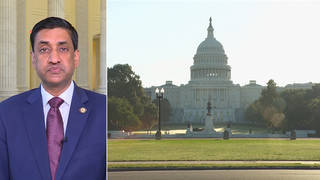
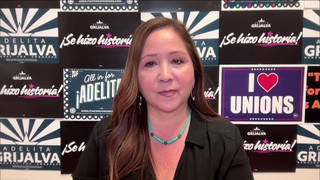
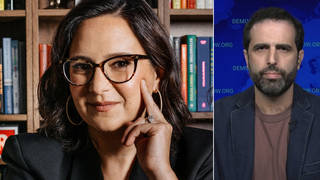
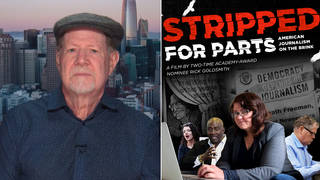





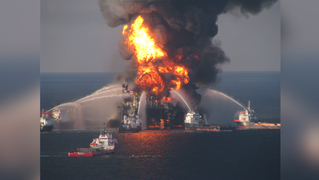
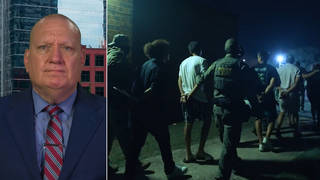
Media Options